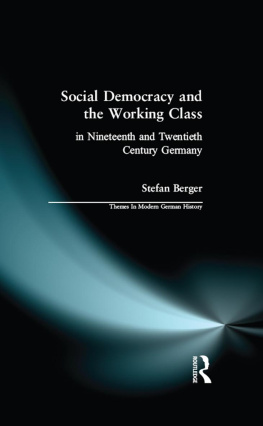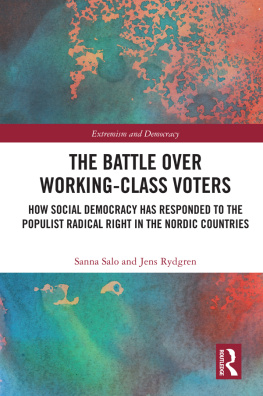Stefan Berger - Social Movements in the Nordic Countries Since 1900
Here you can read online Stefan Berger - Social Movements in the Nordic Countries Since 1900 full text of the book (entire story) in english for free. Download pdf and epub, get meaning, cover and reviews about this ebook. publisher: Klartext, genre: Politics. Description of the work, (preface) as well as reviews are available. Best literature library LitArk.com created for fans of good reading and offers a wide selection of genres:
Romance novel
Science fiction
Adventure
Detective
Science
History
Home and family
Prose
Art
Politics
Computer
Non-fiction
Religion
Business
Children
Humor
Choose a favorite category and find really read worthwhile books. Enjoy immersion in the world of imagination, feel the emotions of the characters or learn something new for yourself, make an fascinating discovery.

- Book:Social Movements in the Nordic Countries Since 1900
- Author:
- Publisher:Klartext
- Genre:
- Rating:3 / 5
- Favourites:Add to favourites
- Your mark:
- 60
- 1
- 2
- 3
- 4
- 5
Social Movements in the Nordic Countries Since 1900: summary, description and annotation
We offer to read an annotation, description, summary or preface (depends on what the author of the book "Social Movements in the Nordic Countries Since 1900" wrote himself). If you haven't found the necessary information about the book — write in the comments, we will try to find it.
Stefan Berger: author's other books
Who wrote Social Movements in the Nordic Countries Since 1900? Find out the surname, the name of the author of the book and a list of all author's works by series.
Social Movements in the Nordic Countries Since 1900 — read online for free the complete book (whole text) full work
Below is the text of the book, divided by pages. System saving the place of the last page read, allows you to conveniently read the book "Social Movements in the Nordic Countries Since 1900" online for free, without having to search again every time where you left off. Put a bookmark, and you can go to the page where you finished reading at any time.
Font size:
Interval:
Bookmark:

in the Nordic Countries
since 1900

glz. Mitteilungsblatt des Instituts fr soziale Bewegungen
Editor-in-chief | Stefan Berger |
Director of the Institute for Social Movements | |
Ruhr-Universitt Bochum | |
Clemensstrae 1719 | D-44789 Bochum (Germany) | |
Guest Editor | David Redvaldsen |
Editorial Board | John Chalcraft, London School of Economics and Political Science |
Andreas Eckert, Humboldt-Universitt zu Berlin | |
Susan Eckstein, Boston University | |
Felicia Kornbluh, University of Vermont | |
Jie-Hyun Lim, Hanyang University | |
Rochana Majumdar, University of Chicago | |
Jrgen Mittag, Deutsche Sporthochschule Kln | |
Walther Mller-Jentsch, Ruhr-Universitt Bochum | |
Holger Nehring, University of Sheffield | |
Dieter Rucht, Wissenschaftszentrum Berlin fr Sozialforschung | |
Sean Scalmer, University of Melbourne | |
Marcel van der Linden, International Institute of Social History, Amsterdam | |
Thomas Welskopp, Universitt Bielefeld | |
Managing Editor | Christian Wicke, Ruhr-Universitt Bochum |
Enquiries: | |
Editorial Support | Martin Sobek |
Layout and typesetting: Klartext Medienwerkstatt GmbH, Essen | |
Cover design: | Volker Pecher, Essen |
Cover photo: | The 1897 Scandinavian Worker Congress, held in Stockholm. |
By permission of the Archive and Library of the Labour Movement, Oslo. |
Publishing and distribution Klartext Verlag, Helerstrae 37, D-45329 Essen, Germany Tel.: +49 (0)201 86206-33, Fax: +49 (0)201 86206-22, |  |
A single copy costs 7.60 , plus shipping costs. A subscription (minimum two journals per year) costs 14.00 , incl. shipping costs within Germany, plus 6.00 from abroad. The journal can be ordered via Klartext < .
Any requests for permission to copy this material should be directed to the Managing Editor.
eISBN 978-3-8375-1132-1ISSN 2197-0386 (Print)ISSN 2197-0394 (online)
Verein zur Frderung des Instituts fr soziale Bewegungen
Font size:
Interval:
Bookmark:
Similar books «Social Movements in the Nordic Countries Since 1900»
Look at similar books to Social Movements in the Nordic Countries Since 1900. We have selected literature similar in name and meaning in the hope of providing readers with more options to find new, interesting, not yet read works.
Discussion, reviews of the book Social Movements in the Nordic Countries Since 1900 and just readers' own opinions. Leave your comments, write what you think about the work, its meaning or the main characters. Specify what exactly you liked and what you didn't like, and why you think so.






